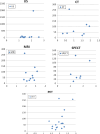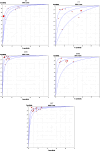FDG-PET and other imaging modalities for the evaluation of breast cancer recurrence and metastases: a meta-analysis
- PMID: 20091186
- PMCID: PMC2874488
- DOI: 10.1007/s00432-009-0746-6
FDG-PET and other imaging modalities for the evaluation of breast cancer recurrence and metastases: a meta-analysis
Abstract
Background and purpose: Breast carcinoma is the most common cancer in female patients with a propensity for recurrence and metastases. The accuracy of ultrasound (US), computed tomography (CT), magnetic resonance imaging (MRI), scintimammography (SMM) and positron emission tomography (PET) in diagnosing the recurrent and/or breast cancer has never been systematically assessed, and present systematic review was aimed at this issue.
Methods: MEDLINE and EMBASE were searched for articles dealt with detection of recurrent and/or metastatic breast cancer by US, CT, MRI, SMM or PET whether interpreted with or without the use of CT. Histopathologic analysis and/or close clinical and imaging follow-up for at least 6 months were used as golden reference. We extracted data to calculate sensitivity, specificity, summary receiver operating characteristic curves and area under the curve and to test for heterogeneity.
Result: In 42 included studies, US and MRI had highest pooled specificity (0.962 and 0.929, respectively); MRI and PET had highest pooled sensitivity (0.9500 and 0.9530, respectively). The AUC of US, CT, MRI, SMM and PET was 0.9251, 0.8596, 0.9718, 0.9386 and 0.9604, respectively. Results of pairwise comparison between each modality demonstrated that AUC of MRI and PET was higher than that of US or CT, p < 0.05. No statistical significance was found between MRI and PET. There was heterogeneity among studies and evidence of publication bias.
Conclusion: In conclusion, MRI seemed to be a more useful supplement to current surveillance techniques to assess patients with suspected recurrent and/or metastatic breast cancer. If MRI shows an indeterminate or benign lesion or MRI was not applicable, FDG-PET could be performed in addition.
Figures
Similar articles
-
Detection of recurrent prostate cancer after radical prostatectomy: comparison of 11C-choline PET/CT with pelvic multiparametric MR imaging with endorectal coil.J Nucl Med. 2014 Feb;55(2):223-32. doi: 10.2967/jnumed.113.123018. Epub 2014 Jan 16. J Nucl Med. 2014. PMID: 24434294
-
Evaluation of ¹⁸F-FDG PET/MRI, ¹⁸F-FDG PET/CT, MRI, and CT in whole-body staging of recurrent breast cancer.Eur J Radiol. 2016 Feb;85(2):459-65. doi: 10.1016/j.ejrad.2015.12.010. Epub 2015 Dec 19. Eur J Radiol. 2016. PMID: 26781152
-
Comprehensive imaging of tumor recurrence in breast cancer patients using whole-body MRI at 1.5 and 3 T compared to FDG-PET-CT.Eur J Radiol. 2008 Jan;65(1):47-58. doi: 10.1016/j.ejrad.2007.10.021. Epub 2007 Dec 20. Eur J Radiol. 2008. PMID: 18082989
-
Positron emission tomography alone, positron emission tomography-computed tomography and computed tomography in diagnosing recurrent cervical carcinoma: a systematic review and meta-analysis.Arch Med Sci. 2014 May 12;10(2):222-31. doi: 10.5114/aoms.2014.42572. Epub 2014 May 13. Arch Med Sci. 2014. PMID: 24904653 Free PMC article. Review.
-
A two-way comparison of whole-body 18FDG PET-CT and whole-body contrast-enhanced MRI for distant metastasis staging in patients with malignant tumors: a meta-analysis of 13 prospective studies.Ann Palliat Med. 2020 Mar;9(2):247-255. doi: 10.21037/apm.2020.02.30. Epub 2020 Mar 18. Ann Palliat Med. 2020. PMID: 32233618 Review.
Cited by
-
Health-Related Suffering and Palliative Care in Breast Cancer.Curr Breast Cancer Rep. 2021;13(4):241-246. doi: 10.1007/s12609-021-00431-1. Epub 2021 Nov 16. Curr Breast Cancer Rep. 2021. PMID: 34804375 Free PMC article. Review.
-
Recent Trends in PET Image Interpretations Using Volumetric and Texture-based Quantification Methods in Nuclear Oncology.Nucl Med Mol Imaging. 2014 Mar;48(1):1-15. doi: 10.1007/s13139-013-0260-2. Epub 2014 Jan 22. Nucl Med Mol Imaging. 2014. PMID: 24900133 Free PMC article. Review.
-
PET Molecular Imaging in Breast Cancer: Current Applications and Future Perspectives.J Clin Med. 2024 Jun 13;13(12):3459. doi: 10.3390/jcm13123459. J Clin Med. 2024. PMID: 38929989 Free PMC article. Review.
-
Quantitative Evaluation of Therapeutic Response by FDG-PET-CT in Metastatic Breast Cancer.Front Med (Lausanne). 2016 May 9;3:19. doi: 10.3389/fmed.2016.00019. eCollection 2016. Front Med (Lausanne). 2016. PMID: 27243012 Free PMC article.
-
Positron emission tomography for benign and malignant disease.Surg Clin North Am. 2011 Feb;91(1):249-66. doi: 10.1016/j.suc.2010.10.012. Surg Clin North Am. 2011. PMID: 21184913 Free PMC article. Review.
References
-
- Aide N, Huchet V, Switsers O, Heutte N (2007) Influence of CA 15-3 blood level and doubling time on diagnostic performances of 18F-FDG PET in breast cancer patients with occult recurrence. Nucl Med Commun 28(4):267–272 - PubMed
-
- American Cancer Society (2002) Breast cancer facts and figures. American Cancer Society, Atlanta, GA, pp 9–10
-
- Bäz E, Madjar H, Reuss C, Vetter M (2000) The role of enhanced Doppler ultrasound in differentiation of benign vs. malignant scar lesion after breast surgery for malignancy. Ultrasound Obstet Gynecol 15(5):377–382 - PubMed
-
- Belli P, Pastore G, Romani M, Terribile D, Canadè A (2002) Role of magnetic resonance imaging in the diagnosis of recurrence after breast conserving therapy. Rays 27(4):241–257 - PubMed



